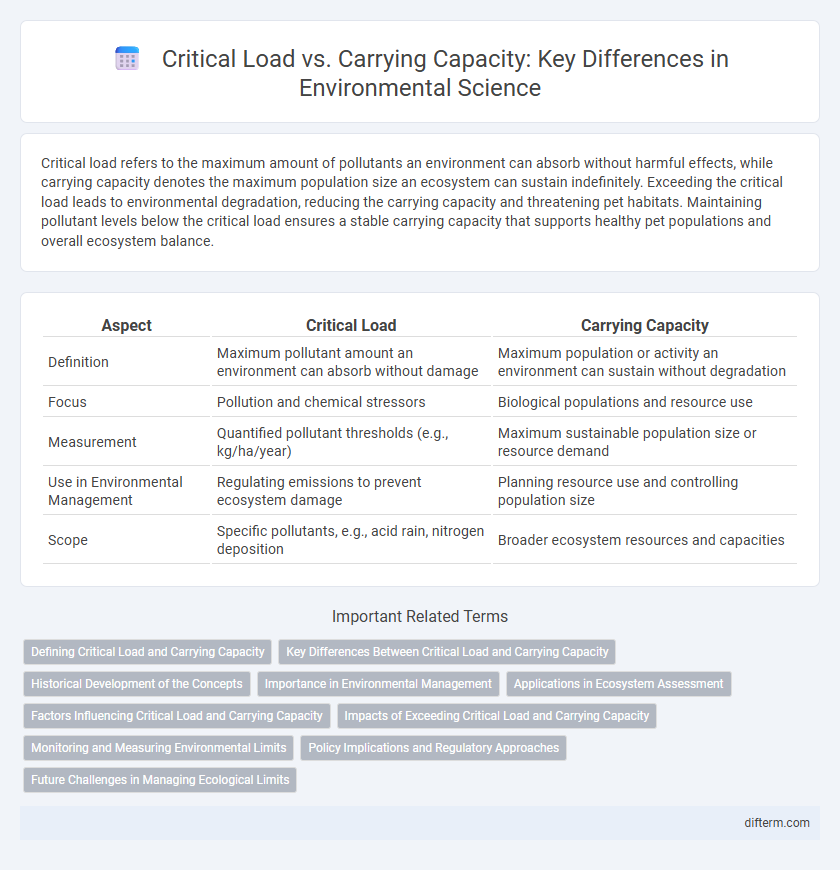Critical load refers to the maximum amount of pollutants an environment can absorb without harmful effects, while carrying capacity denotes the maximum population size an ecosystem can sustain indefinitely. Exceeding the critical load leads to environmental degradation, reducing the carrying capacity and threatening pet habitats. Maintaining pollutant levels below the critical load ensures a stable carrying capacity that supports healthy pet populations and overall ecosystem balance.
Table of Comparison
| Aspect | Critical Load | Carrying Capacity |
|---|---|---|
| Definition | Maximum pollutant amount an environment can absorb without damage | Maximum population or activity an environment can sustain without degradation |
| Focus | Pollution and chemical stressors | Biological populations and resource use |
| Measurement | Quantified pollutant thresholds (e.g., kg/ha/year) | Maximum sustainable population size or resource demand |
| Use in Environmental Management | Regulating emissions to prevent ecosystem damage | Planning resource use and controlling population size |
| Scope | Specific pollutants, e.g., acid rain, nitrogen deposition | Broader ecosystem resources and capacities |
Defining Critical Load and Carrying Capacity
Critical load refers to the maximum level of pollutant deposition that an ecosystem can tolerate without experiencing harmful effects, while carrying capacity denotes the maximum population size or biomass that a particular environment can sustain indefinitely. Understanding critical load is essential for determining pollutant thresholds to prevent ecosystem degradation, whereas carrying capacity informs resource management by defining ecological limits for species survival. Both concepts are fundamental in environmental science for maintaining ecosystem balance and preventing irreversible damage.
Key Differences Between Critical Load and Carrying Capacity
Critical load refers to the maximum level of pollutants an ecosystem can tolerate without suffering harmful effects, while carrying capacity denotes the maximum population size an environment can sustain indefinitely given available resources. Critical load primarily addresses chemical stressors and ecosystem health, whereas carrying capacity focuses on biological limits and resource availability for species survival. Understanding these distinctions aids in effective environmental management and pollution control strategies.
Historical Development of the Concepts
The concepts of critical load and carrying capacity emerged from ecological studies in the mid-20th century, initially addressing pollution thresholds and ecosystem sustainability respectively. Critical load was developed to quantify the maximum deposition of pollutants ecosystems can tolerate without damage, forming a basis for air quality standards. Carrying capacity originated from population ecology, defining the maximum population size an environment can support indefinitely without degradation.
Importance in Environmental Management
Critical load defines the maximum level of pollutant deposition an ecosystem can endure without harmful effects, while carrying capacity determines the maximum population or activity level an environment can sustain over time. Understanding the disparity between critical load and carrying capacity is essential for preventing ecosystem degradation and ensuring sustainable resource use. Effective environmental management integrates these concepts to set regulatory limits that maintain ecological balance and promote long-term resilience.
Applications in Ecosystem Assessment
Critical load refers to the maximum level of pollutant deposition an ecosystem can tolerate without experiencing harmful effects, while carrying capacity denotes the maximum population size or resource use an environment can sustain indefinitely. Applying these concepts in ecosystem assessment enables accurate evaluation of ecosystem health by identifying thresholds beyond which degradation occurs. This approach supports effective management strategies for preserving biodiversity, maintaining soil fertility, and preventing water quality decline.
Factors Influencing Critical Load and Carrying Capacity
Critical load and carrying capacity are influenced by factors such as ecosystem resilience, pollutant deposition rates, and nutrient cycling efficiency. Soil quality, vegetation type, and climate conditions regulate the ability of environments to absorb stress without degradation. Human activities, including land use changes and industrial emissions, also play a significant role in determining these environmental thresholds.
Impacts of Exceeding Critical Load and Carrying Capacity
Exceeding the critical load in ecosystems leads to irreversible damage such as soil degradation, loss of biodiversity, and water pollution, disrupting natural nutrient cycles. When carrying capacity is surpassed, resource depletion and habitat destruction occur, causing population declines and ecosystem collapse. These impacts highlight the urgent need for sustainable resource management to maintain ecological balance and resilience.
Monitoring and Measuring Environmental Limits
Monitoring critical load involves quantifying the maximum pollutant input an ecosystem can absorb without detrimental effects, while carrying capacity measures the maximum population or activity level an environment can sustain over time. Accurate measurement techniques, such as remote sensing and bioindicators, are essential for assessing these environmental thresholds and preventing ecosystem degradation. Implementing continuous data collection and modeling enhances the precision of environmental limits, supporting sustainable resource management and conservation efforts.
Policy Implications and Regulatory Approaches
Critical load defines the maximum amount of pollutant deposition an ecosystem can tolerate without adverse effects, while carrying capacity refers to the long-term sustainable support level for biotic communities. Effective environmental policies must integrate both concepts to establish regulatory thresholds that prevent ecosystem degradation and promote resilience. Regulatory approaches based on these metrics prioritize adaptive management strategies, emission controls, and continuous monitoring to align human activities with ecosystem tolerance limits.
Future Challenges in Managing Ecological Limits
Critical load defines the maximum pollutant input an ecosystem can tolerate without significant harm, while carrying capacity refers to the maximum population or biomass an environment can sustain indefinitely. Future challenges in managing ecological limits involve balancing these thresholds amid climate change, habitat loss, and increased human activities that intensify stress on ecosystems. Integrating dynamic models of critical load and carrying capacity with real-time environmental data is essential for adaptive management and maintaining biodiversity resilience.
critical load vs carrying capacity Infographic

 difterm.com
difterm.com